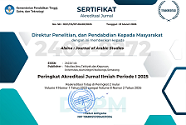Problematika Membaca Teks Arab bagi Siswa Madrasah
DOI:
https://doi.org/10.21580/alsina.1.1.3666Keywords:
madrasah, problematika membaca, teks ArabAbstract
Learning to read the text of the Qur'an and hadith at the initial level is to sound the letters of the Qur'an and the hadith itself. Learning to read the Qur'an means learning to pronounce written symbols (letters). The Qur'an and hadith are revealed in Arabic and become a foreign language in learning. Especially in reading the Qur'an, Allah has set rules in reading the Qur'an such as laws and rules. This study aims to describe the problems experienced by students in reading the texts of the Qur'an and hadith. This study uses a qualitative approach with descriptive-analytical methods and data collection techniques are observations. The subjects of this study were grade 3 students of MI Walisongo Semarang, totaling 45 people consisting of 6 men and 39 women. The results of the study explain the problem of reading the Qur'anic text and hadith, including: pronunciation of the sounds of the letters hijaiyah (makhorijul letters), short length of charity, and the law of reading (tajwid). And in terms of the environment, namely: students lack focus on learning materials, teacher teaching skills, lack of interest and activities of students in learning to read the Qur’an and hadith, lack of time, facilities and infrastructure for student learning, both at school and at home, and not supporting the community environment.Downloads
References
Agustina, Nora. 2018. Perkembangan Peserta Didik. Yogyakarta: Deepublish.
Bulaeng. 2016. Peningkatan Kemampuan Membaca Al-Qur’an Dengan Tartil Melalui Metode Iqra Pada Peserta Didik Kelas V Di SD Inpres Tinggimae Kecamatan Somba Opu Kabupaten Gowa. Skripsi. Fakultas Tarbiyah dan Keguruan, Universitas Islam Negeri Alauddin Makassar.
Depag RI. 1997. Metode-metode Membaca Al-Qur’an di Sekolah Umum. Jakarta: Dirjen Pembinaan Kelembagaan Agama Islam.
Departemen Agama Republik Indonesia. 2012. Al-Qur’an dan Terjemahannya. Bandung: PT. Sinergi Pustaka Indonesia.
Jamaris, Martini. 2014. Kesulitan Belajar Perspekif, Assessment, dan Penanggulanganya Bagi Anak Usia Dini dan Usai Sekolah. Bogor: Ghalia Indonesia.
Jannah, Roichatul dan Siti Nur Kholifah. 2016. Peningkatan Keterampilan Membaca Tulisan Arab dengan Menggunakan Strategi Pembelajaran Aktif Tipe Sort Card bagi Peserta didik Kelas II MI Banu Hasyim Sidoarjo. J. PTK-PAI: Penelitian Tindakan Kelas-Pendidikan Agama Islam 7 (2).
Ramli, M. Hakikat Pendidik dan Peserta Didik. Tarbiyah Islamiyah: Jurnal: Jurnal Ilmiah Pendidikan Agama Islam 5 (1).
Saputra, M. Indra. 2015. Hakekat Pendidik dan Peserta Didik dalam Pendidikan Islam. At-Tadzkiyyah: Jurnal Pendidikan Islam 6 (2).
Tim Penulis. Metodik Khusus Pengajaran Agama Islam. Jakarta : Direktorat jenderal Pembinaan Kelembagaan Agama Islam.
Ufie, Agustinus. 2013. Kearifan Lokal (Local Wisdom) Budaya Ain Ni Ain Masyarakat Kei sebagai Sumber Belajar Sejarah Lokal untuk Memperkokoh Kohesi Sosial Siswa. Thesis. Program Studi Pendidikan Sejarah, Universitas Pendidikan Indonesia.
Downloads
Published
How to Cite
Issue
Section
License
Copyright
The copyright of the received article shall be assigned to the publisher of the journal. The intended copyright includes the right to publish the article in various forms (including reprints). The journal maintains the publishing rights to published articles. Authors are allowed to use their articles for any legal purposes deemed necessary without written permission from the journal, but with an acknowledgment to this journal of initial publication.
Licensing
In order for Alsina: Journal of Arabic Studies to publish and distribute research articles, the editors need publishing rights (transferred from author to publisher). This agreement relates to the transfer/publishing copyright license to Alsina: Journal of Arabic Studies but the authors still have significant rights to use and share their published articles.
Alsina: Journal of Arabic Studies supports the need for writers to share, disseminate and maximize the impact of their research and their rights on any database. As a journal article writer, you have the right to various uses of your articles, including that by the institution or company where you work. Copyright can be used without the need for special permission. Authors who publish articles in the Alsina: Journal of Arabic Studies have broad rights to use their work for teaching and scientific purposes without requesting permission, including:
- Use by the author for lectures, presentations, or conferences, with distribution of copies to participants;
- Distribution to colleagues for research use;
- Use in compilations of the author's subsequent work;
- inclusion in a thesis or dissertation;
- Reuse of sections or excerpts from articles in other works (with full acknowledgment of the final article);
- Preparation of derivative works (other than commercial purposes) (with full acknowledgment of the final article);
- Voluntary posting on open websites operated by authors’ or writers' agencies for scientific purposes
When submitting a manuscript, authors do so on the understanding that if accepted for publication, the copyright for publishing (publishing right) of the article shall be assigned/transferred to Alsina: Journal of Arabic Studies.
Authors whose articles are accepted for publication will receive confirmation via email and sent a Copyright Transfer Agreement.


 Accreditation
Accreditation 
 In Collaboration with
In Collaboration with 

 Visitors
Visitors  Article Template
Article Template





